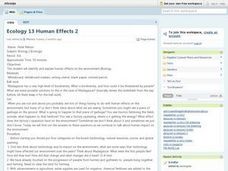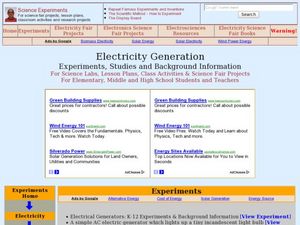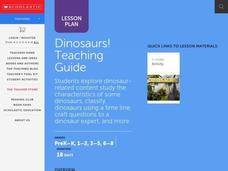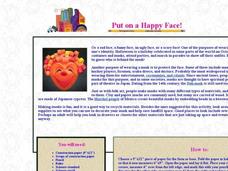Curated OER
Crazy Hair
Students decorate small styrofoam cups with faces and plant grass seeds in the cups in this Science and Art lesson for the early-elementary classroom. Emphasis is placed upon the science of seed growth. The lesson includes resource links.
Curated OER
What is a Dry Forest?
Students explore the importance of the dry forest. In this science lesson plan, students discuss the history of dry forests and changes that have occurred due to human interaction. Students create a map showing the historical range of...
Curated OER
Clay Sculpture: Relationships
Students explore art history by conducting an in-class activity. In this sculpting lesson, students examine previously created art sculptures in a textbook. Students utilize clay, sculpting tools and grey paper to create their own...
Curated OER
Why Are Volcanoes Dangerous?
Students investigate the causes and characteristics of volcanic eruptions including pyroclastic eruptions. They study the effects of natural disasters.
Curated OER
Ecology 13 Human Effects 2
Students identify and explain human effects on the environment. They explore the terms biodiversity, natural resources, ozone and global warming. After exploring all the terms , they connect technology to them and how it effects the...
Curated OER
Exploring the Night Sky: Fall/Winter
Students explain how moon phases occur. They explain three ways that the night sky has been used through history. Students locate some of the constellations in the night sky. They discuss stories and myths surrounding stars.
Curated OER
Activity One -- Fundamentally Speaking
In this science worksheet, students examine how the universe is bound with the atomic particles and focus upon the findings of two historical scientists.
Curated OER
Hawaiian Hot Spots
Students describe how plate tectonics contribute to the development of volcanoes. In this earth science instructional activity, students examine the map of Hawaii and explore the physical and biological environment there. They write a...
Curated OER
Germs Can Make You Sick
Students explore how germs are spread. In this science lesson, students practice good hand washing practices and discuss how washing hands can prevent the spread of germs.
Curated OER
Impact Craters
Students investigate the factors affecting the size of a crater. In this space science instructional activity, students collect data from the activity and graph them. They explain how velocity of impact relate to crater size.
Curated OER
Making Sedimentary Rocks
Students make models of sedimentary rock layers to explain how rocks form layers and represent ancient environments. Layers of sediment and fossils are added together to simulate the environment and connections to sedimentary rocks are...
Curated OER
Be a Whale
Students explore the body shape, behavior and history of gray whales by creating origami whale hats. Students role-play whale behavior as they listen to a story.
Curated OER
Dating Sedimentary Strata
Students investigate how the age of sedimentary strata is determined. For this sedimentary strata lesson, students work through problems that show that geological history covers millions of years. They distinguish between relative and...
Curated OER
Electricity Generation
Learners study the history of electricity and the different ways we generate electricity. In this electricity lesson students complete several experiments on generating power.
Curated OER
Operation Mexfly
Students research information about pesticides. Students discuss the history of the Mexican fruit fly. They experiment to discover malathion concentration levels in organisms. Students explore the effect of toxins at the top of the...
Curated OER
Water: H2O = Life
In this earth science worksheet, pupils explore and describe animals and their adaptations, including their habitats, physical characteristics, and competing organisms. They also explore and describe how others use water around the...
Curated OER
An Elephant Never Forgets
Learners are introduced to the Addo Elephant National Park in South Africa. In this natural science lesson plan, students identify the elephants by name according to the diagrams. Learners study the unique characteristics of the...
Curated OER
Solar System: The Four Inner Planets and Earth's Moon and Astronauts
Second graders read THe Magic School Bus: Lost in the Solar System. In this language arts and science lesson, 2nd graders explore the four inner planets. Students view the inner planets using Google Earth.
Curated OER
Sanctuary: Quail Island Banks Peninsula
Students consider the connection between the past and future landscape of Quail Island. In this visual arts instructional activity, students observe existing artwork, art vocabulary, and connections to the role of social sciences when...
Curated OER
Channel Islands and the Surrounding Sea
Students examine the Channel Islands and identify its characteristics. They participate in activities to help them discover the islands history, geography and conservation efforts. They complete a worksheet to end the lesson.
Curated OER
The Invasion of the Medfly
Students examine the invasion of the fruit fly in California. In groups, they observe and record the fruit fly's lifecycle and how they affect humans in society. They also discuss the history and geography of the fly and the different...
Curated OER
Dinosaurs
Young scholars will develop goals for inquiry. They will also improve content area reading and research skills. The context of studying dinosaurs will help learners to distinguish from organisms that live presently and those from the...
Curated OER
Species Interactions
Eighth graders explore seven terrestrial biomes. They compare relationships between children, parents and friends to interactions among species. After observing pictures of types of interaction, 8th graders describe the predator-prey...
Curated OER
Put on a Happy Face!
Students explore using recycled materials. In this ecology/art lesson, students use recycled materials to create a Halloween mask. Students view folk art made of natural and available resources, and discuss possible cultural uses for...

























